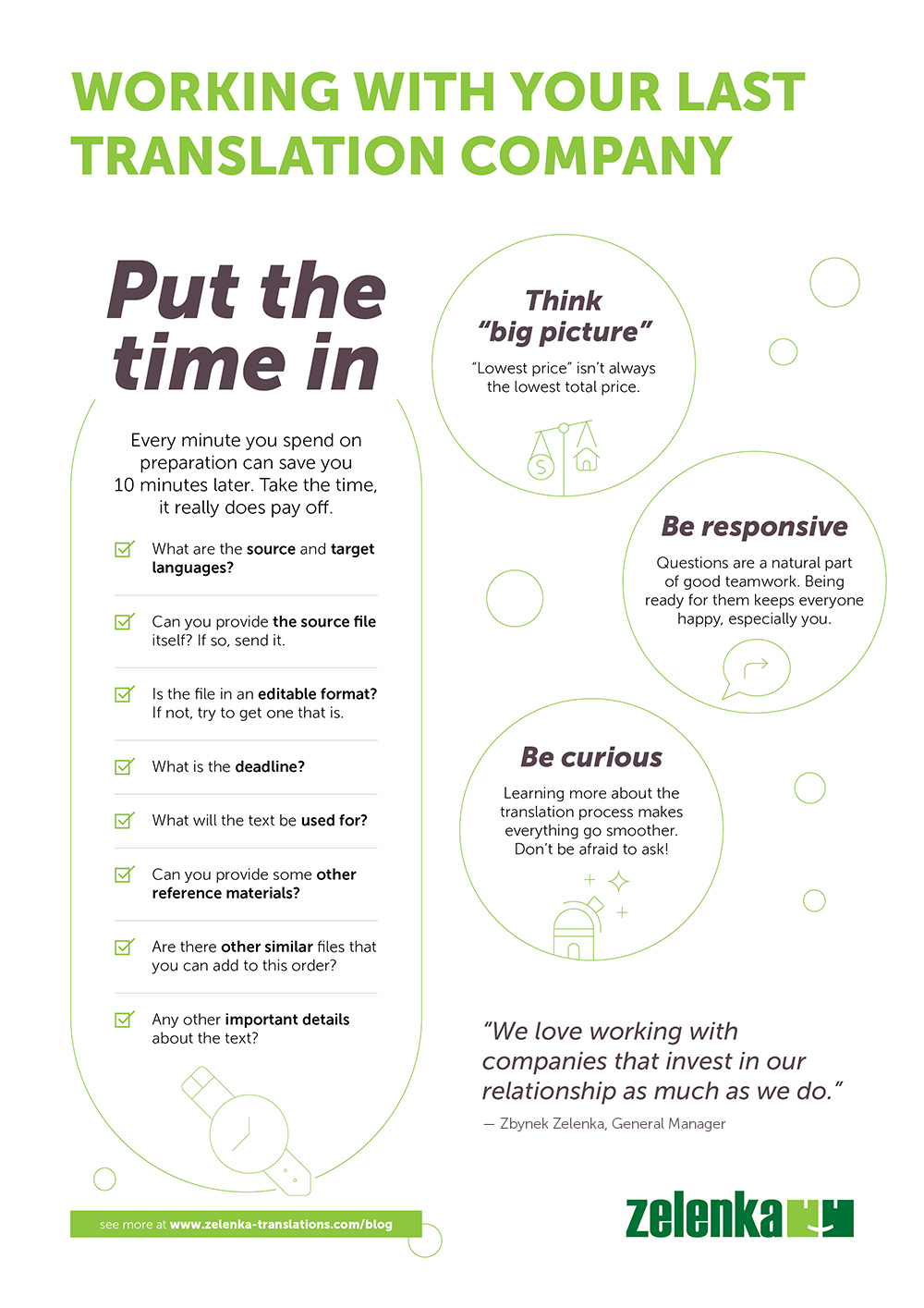How to Enjoy Working with Any Translation Company

Zbyněk Zelenka
11. 12. 2018When I’m talking to new clients, I make a point to ask them what kind of experience they’ve had with other translation companies in the past. I personally enjoy this topic because it gives me insight into what their relationship was like and how much they know about the translation process.
Over the years I’ve noticed that most of the struggles that companies feel when dealing with a language service provider can be narrowed down to one of four different themes:
- Deadlines - translations were often delivered late
- Quality - translations often required a lot of extra work from the client’s side, usually due to problems with style or terminology
- Price and overall costs - the quoted price was unrealistic, unexpected additional services were needed to complete the job, or the clients had to invest significant time correcting mistakes personally
- Transparency (the most interesting one for me) - clients felt unpleasantly detached from the translation process, even though they wished to know more about what was going on, why, and how they could help
Though these four categories are different, a problem in one of them usually leads to issues with the others, as well. For instance, a poorly set deadline can produce a lower quality translation, which the client then needs to spend time and resources editing or resolving.
In my mind, though, all of these issues originate in the Transparency category. Understanding how your translation company works not only makes the process smoother and more efficient for both sides, it also creates a relationship that makes the work more enjoyable.
Here are some tips to help you enjoy working with a translation company and make you one of their absolute favorite clients.
Put the time in
There are lots of ways to translate a text and the best are always driven by lots of information being shared from both sides.
One of the most effective ways to improve the process is to invest time into preparing your order before you send it for translation.
Here are some things you can provide to make sure you get the highest quality translations possible and perhaps even save some money in the process.
-
What are the source and target languages?
Simply state which language the text is in and which language you need it translated into. Sometimes your documents can contain multiple languages and that’s fine, just be sure to mention.
-
Can you provide the source file itself?
Even if you’re still in the deciding phase and asking a company for a quote, the source file contains lots of useful information that they can use to provide a more realistic one.
-
What format is the file in? Is it editable?
In order to process a translation, a company performs an analysis of the document to determine how much text it contains and several other important aspects. The easiest way to help with this is to send a file that is editable. This can be, for instance, a Word document or even a special PDF that lets a user copy and paste the text from it. If you aren’t sure if a certain file type is right, the company’s project manager is a great resource for that kind of information.
If you can’t provide the text in an editable format, some companies have specialists who can extract the text from it to prepare it for translation. Just bear in mind that this process not only takes more time, but it also adds to the overall price.
-
What is the deadline?
Knowing when you need the file back helps the translation company prioritize the job and manage the capacity of their translators.
If you’re working with a company you can rely on (which should definitely be the case), then it’s important to discuss the deadline with them and give them as much time as possible to complete the job. You’d be surprised by the difference a single extra day can make.
-
What will the text be used for?
This will help the company suggest an appropriate quality level and potentially save you money. For instance, texts for internal communication usually require fewer additional services than marketing materials do and as a result are less expensive.
Knowing the intended purpose of the text also helps translators select a linguistic style that will be most effective.
-
Can you provide some other reference materials?
When it comes to translating a text, context helps immensely. Before a translator starts working on a file, they have to decide what style to use. Providing materials for them to study ensures that they choose a style that resonates with your company. Company catalogues and previously translated documents are great examples of such reference materials.
-
Are there other similar files that you can add to this order?
Look for ways in your processes to combine several smaller translations into one, larger order. This reduces processing time for everyone involved and also helps ensure that the agency finds the best translators possible.
-
Are there any other important details about the text?
As I mentioned before, providing context is one of the easiest ways to improve the entire process. Feel free to add more information about the job into your order, even if you’re not sure it’s relevant. There’s no such thing as too much context.
Compare “apples to apples”
The lowest quote may not always be the best way to go. If a quote from one company is much lower than others, make sure to look closely before deciding. It’s possible that the lower price doesn’t include some important services, such as proofreading.
In addition, it’s important to remember that “low-cost” translation services can actually end up costing you more money in time spent resolving issues with the final result.
Be responsive
Translators often have extra questions about a particular text. In many cases, the agency will be able to answer them. If not, then it is important to provide requested information as quickly as possible. This keeps the process moving smoothly and greatly increases the quality of the result.
Be curious
Take an interest in how your translation company processes your texts and make sure they know you are interested. Don’t be afraid to ask about how the translation process works and take every chance you have to learn something more about it. This knowledge can save a lot of money and makes the entire process more enjoyable.
YOUR LAST TRANSLATION COMPANY
I personally love working with companies that invest in our working relationships as much as we do.
Look for a language partner, LSP, translation company (or whatever you want to call it) with a similar approach, even if it’s not us. And when you do find it, make that the last translation company you work with – you won’t need another.
Your business will thrive for it.

Zbynek Zelenka
General Manager at ZELENKA Translations
If you liked these ideas, we created a useful checklist infographic that you can download here to help you keep these points in mind.


